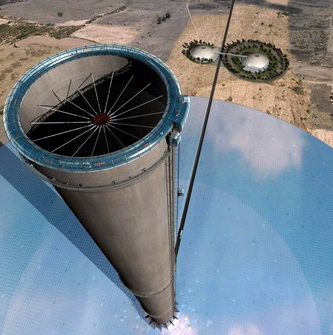Chimneys chasing panels' place in the sun
 While solar panels gain popularity – and increase in efficiency – around the world, experts say some alternative design could help us gain more free power from the Sun.
While solar panels gain popularity – and increase in efficiency – around the world, experts say some alternative design could help us gain more free power from the Sun.
One exciting alternative is solar updraft technology, which uses tall solar “chimneys” to take air heated by the sun to generate energy, rather than through direct solar radiation.
‘Solar chimneys’ are particularly suited to hot and arid climates, overcoming some of the limitations that hamper conventional solar cells.
Solar updraft technology uses sunlight to heat air contained in an immense transparent canopy positioned that sits between two and 20 metres above the ground.
A tall, hollow updraft tower sits in the middle, which allows the warm are to be concentrated and rise up through the chimney, powering turbines on its way up.
The technology can be used anywhere where there is flat land and ample sunlight.
Solar updraft is not dependent upon direct sunlight to generate electricity, and so has some key advantages over traditional photovoltaic cells.
It can overcome the intermittency issues that plague other styles of solar energy generation by continuing to operate as long as the air in the canopy is at a sufficient temperature.
Solar energy is trapped in the Earth in the form of heat well after sunset, providing even more input for an updraft plant. The land’s ability to trap heat can even be improved by the use of simple, cost-effective measures, such as the addition of a layer of gravel on the ground surface.
Solar chimneys are less concerned by the presence of dust or grit in the atmosphere as well – alleviating a major problem in the desert environments that are often considered for photovoltaic cell installations.
Solar chimneys are inhibited by one major drawback – the cost.
Solar updraft facilities need to be built on an immense scale to account for their low efficiency rate – just one or two per cent, as compared to up to 15 per cent efficiency for photovoltaic cells.
But there has been some uptake in Australia, including at a tin mine in Western Australia.
German engineering firm Schlaich Bergermann and Partner (SBP) is working on a 200-megawatt solar updraft facility in collaboration with Hyperion Energy.
The project will see the construction of a one-kilometre high cement and steel chimney, surrounded a canopy measuring a staggering 10 kilometres in diameter.
The estimated cost is about $US1.67 billion.
But once the large initial funding costs are overcome, solar chimneys can generate electricity at costs roughly equivalent to standard forms of solar power.








 Print
Print